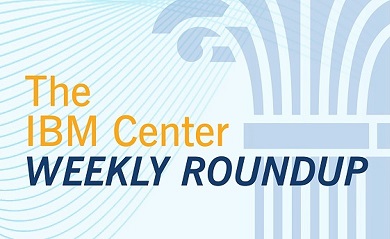
Weekly Roundup: January 27-31, 2025

Artificial Intelligence and Innovation
Fed AI Committee Offers Recommendations for Trump. The National Artificial Intelligence Advisory Committee (NAIAC), which advises the president and the White House on the National AI Initiative, approved a draft report this week with 10 focus areas for President Trump to pursue during his second term. The 10 priority policy issues are AI in relation to the workforce; awareness and literacy; education; science; health; government; empowerment of small businesses, entrepreneurs, and nonprofits; governance; American people; and law enforcement.
Navy Close to Finalizing ‘AI Strategic Intent’. The Department of the Navy (DON) is putting the finishing touches on its strategic plan for artificial intelligence (AI), which will detail how the Navy intends to incorporate AI into its operations, according to a senior official. Stephanie Tutko, deputy chief data and AI officer for the Office of the DON Chief Information Officer (CIO) offered brief insights into the plan, noting that a key focus will be monitoring mission needs and identifying use cases to develop enterprise AI across the enterprise at scale.
Former DoD Official: Bureaucracy Hindering Innovation Progress. A former Pentagon acquisition official told Senate lawmakers that the Department of Defense (DoD) does not suffer from a lack of innovation, but rather a critical issue with its programming practices which hinders the agency’s ability to effectively deliver cutting-edge technologies to the military. During a Senate Armed Services Committee meeting, James Geurts, the former assistant secretary of the Navy for Research, Development, and Acquisition, said that “the accumulation of decades of statutes, regulations, processes, all well-intentioned [have] permeated the bureaucracy [and] have hobbled our ability to adapt and change.”
How Generative AI Improves Supply Chain Management. Advances in large language models (LLMs), a type of generative AI, are increasingly making it possible to more effectively optimize their supply chains. LLM-based technology can automate data discovery, insight generation, and scenario analysis, reducing the time to make decisions from days to minutes and dramatically increasing planners’ and executives’ productivity and impact. The authors draw on their experiences to explore how LLMs can be used to optimize supply chains. They also identify obstacles organization’s will need to overcome to deploy LLMs effectively.
Why DeepSeek Shouldn’t Have Been a Surprise. The Chinese startup DeepSeek shocked many when its new model challenged established American AI companies despite being smaller, more efficient, and significantly cheaper. However, management theory — specifically disruption theory — could have predicted that a challenger like this would inevitably come along.
Workforce
GAO: Public Health Workers Lack Crucial Data Skills. Public health workers need improved data analytics skills, according to a recent Government Accountability Office (GAO) report that highlights a gap in the health workforce’s ability to better address public health needs and disparities. The report evaluates the Department of Health and Human Services’ efforts to address workforce gaps in public health and found that informatics-related abilities are among skill gaps faced by the current health workforce. “Recent studies indicate that informatics is one of the most significant public health training needs, and can help public health departments improve disease surveillance and better address public health needs and disparities,” said GAO.
Acting CIOs Step In at DoT, SSA. The Department of Transportation (DoT) and the Social Security Administration (SSA) have both filled their chief information officer (CIO) roles in an acting capacity in the early days of the new Trump administration. SSA Acting Commissioner Michelle King has announced Brian Peltier as the acting CIO, an agency spokesperson confirmed. Peltier previously served as SSA’s deputy CIO for strategy and chief AI officer.
OPM details return-to-office plans to agency employees. The agency says it will offer “relocation packages” to remote OPM employees located more than 50 miles from their assigned duty station.
Veterans
VA Nominee Says EHRM Program Is a Top Priority. Doug Collins -- the nominee to lead the Department of Veterans Affairs (VA) – told lawmakers, if confirmed, one of his top priorities will be improving the rollout of the VA’s Electronic Health Records Modernization (EHRM) program. The EHRM program aims to provide a seamless experience for veterans as they transition from receiving care under the Department of Defense (DoD) to receiving care under the VA, with a single fully integrated EHR system. However, the program has faced a troubled rollout riddled with underreported costs, deficiencies in training, and diminished employee morale. “My commitment is one of the very first priorities of this, if confirmed, is to get in and figure out why, and put this on a bigger time frame to get this medical health records issue solved,” Collins said.
Cyber
Army Secretary Nominee Pledges to Bolster Cyber Force. Daniel Driscoll, President Trump’s pick to become secretary of the Army, vowed during his confirmation hearing to strengthen the Army’s cyber workforce, and promised to prioritize expansion of the service’s cyber force to meet evolving threats in an increasingly digital battlefield. “We are going to have to figure out and work together to create unique pathways for the cyber experts among us to be the most lethal cyber soldier,” Driscoll told members of the Armed Services Committee who are considering his nomination.
Transition Update
Breakneck pace of executive orders and lagging, unclear guidance leave contractors guessing. Professional Services Council President and CEO David Berteau said on a media call this week that the contracting trade association has been keeping track of the torrent of overlapping executive orders that have emerged from the White House over the past week, but because they are applied in expansive and intersecting ways, contractors aren’t sure where they stand amid policy pronouncements, reversals and clarifications. Berteau said that while spending reviews are common for new administrations, the entanglement of what he called an unprecedented number of executive orders from the Trump White House has left contractors seeking clarity from acquisition officials.
Which of Trump's nominees have been confirmed? These individuals will hold huge sway in enacting the president's policies toward federal employees.
Leadership
Leaders Shouldn’t Try to Do It All. The authors, a former CEO of Procter & Gamble and a former dean of the Rotman School, respectively, frequently find themselves sitting across the table from overwhelmed leaders. These executives are trying to improve or turn around an organization or the piece of it they head. Many leaders think they can get more done if they simply work harder and longer. In this article the authors, drawing on their own experience and that of CEOs they have advised, explain how to escape that trap.
5 Signs Your Optimism Is Hurting Your Team. Maintaining a positive outlook is critical for good leadership. Your optimism can inspire your team, drive creativity, and foster a productive work environment. But there’s a fine line between constructive positivity and its harmful counterpart: toxic positivity.. When optimism becomes excessive or dismissive of real challenges, it can backfire, leaving your team feeling unheard and alienated. Here are five signs to look out for in how you act, talk, and behave — and better ways to respond.
How to Make Better Decisions Under Pressure. Many people believe that leaders instinctively make the best decisions based on past experience, almost like muscle memory. But Carol Kauffman, assistant professor at Harvard Medical School and the founder of the Institute of Coaching, challenges this view. She explains why falling back on automatic behaviors can lead to poor decisions, especially when the stakes are high.
THIS WEEK @ THE CENTER
RECENT BLOGS
- How can government improve performance with AI? by Dan Chenok. The recipe for a more efficient U.S. federal government includes eliminating complexity, simplifying how work gets done, and automating manual tasks with artificial intelligence (AI). This blog explores this topic.
- Integrating AI in Government: Lessons, Applications, and Innovations by Michael J. Keegan. This forum is dedicated to exploring the dynamic intersection of AI and government operations, focusing on its current applications, potential, and the critical questions it raises about trust, ethics, and effective implementation.
- Developing the Purpose of Engagement by Julia Carboni. This blog series is designed to equip public leaders and managers with practical tools and strategies for engaging the public in ways that can help restore trust in government. In the first blog post, six aspects of public engagement were introduced. This blog discusses the second aspect of public engagement, “Developing the Purpose of Engagement.”
ICYMI –National Academy of Public Administration FALL MEETING SERIES. This week Michael Keegan welcomed Laura Stanton, Assistant Commissioner, Federal Acquisition Service’s Office of Information Technology Category (ITC), U.S. General Services Administration (GSA) on this Special Edition of The Business of Government Hour – The National Academy of Public Administration FALL MEETING SERIES. This is the final conversations exploring the key challenges facing public management with a focus on technology innovation and procurement strategies.



